Prenatal And Newborn Genetic Testing Market Research, 2031
The global Prenatal and Newborn Genetic Testing Market Size was valued for $4,891.51 million in 2021 and is estimated to reach $14,727.30 million by 2031, exhibiting a CAGR of 11.5% from 2022 to 2031. Prenatal testing provides you with information about your baby’s health. It detects any problems that could affect the health of fetuses like genetic defects and congenital conditions. Doctors recommend some prenatal tests while only a few women need special screening tests. Newborn testing is done to detect abnormalities that can cause certain health conditions such as inborn genetic defects. The genetic diseases that can be detected in newborns during screening are Down syndrome, phenylketonuria, homocystinuria, and others. Therefore it is important to diagnose genetic diseases in the early stages of the pregnancy and within 24 hours of newborn birth.
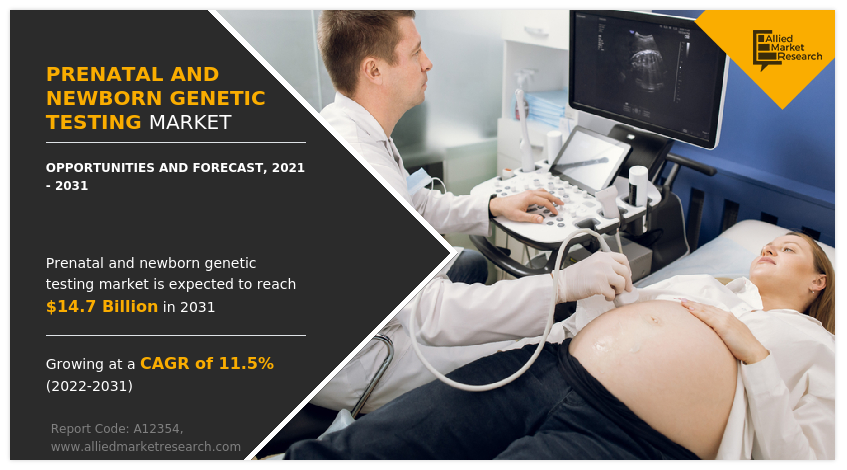
Historical overview
The market was analyzed qualitatively and quantitatively from 2021-2031. The prenatal and newborn genetic testing market grow at a CAGR of around xx% during the forecast period. Most of the growth was derived from the Asia-Pacific region owing to the rise in prevalence of genetic diseases in newborn babies, adoption of novel diagnostic methods for screening, improvement in healthcare facilities, rise in disposable incomes, and well-established presence of domestic companies in the region.
Market dynamics
Growth & innovations in the medical devices industry for the manufacturing of advanced diagnostic and screening devices, owing to a massive pool of health-conscious consumers, creates an opportunity for the prenatal and newborn genetic testing market. The rise in the prevalence of congenital malformations and genetic abnormalities is the major key factor driving the market growth. For instance, according to the World Health Organization (WHO), 6% of babies worldwide are born with a congenital anomaly and it is one of the main causes of the global burden of disease majorly in low and middle-income countries. Furthermore, the rise in demand for non-invasive prenatal screening positively impacts the Prenatal and Newborn Genetic Testing Market Size. Non-invasive prenatal screening methods for genetic testing are being favored by doctors, owing to the advantages of non-invasive invasive sample collection, high accuracy and precision, less pain, and fast diagnosis as compared with the conventional methods.
In addition, the growth of the prenatal and newborn genetic testing market is expected to be driven by high potential in emerging markets, such as India and Japan due to the availability of improved healthcare infrastructure, increase in unmet healthcare needs, rise in the pregnancy rate, and rise in awareness about prenatal and newborn genetic testing. Furthermore, the healthcare industry in emerging economies is developing at a significant rate, owing to rise in demand for enhanced healthcare services and significant investments by the government to improve healthcare infrastructure. The demand for prenatal testing is not only limited to developed countries but is also being witnessed in developing countries, such as China, Japan, and India, which fuel the Prenatal and Newborn Genetic Testing Market Growth.
Factors such as rise in the incidence of Down’s syndrome, an increase in the number of women with advanced maternal age increase in R&D investments in the discovery & development of novel screening methods, and rise in awareness regarding the early detection of diseases, further provide lucrative Prenatal and Newborn Genetic Testing Market Opportunity in upcoming years. For instance, the American College of Obstetricians and Gynecologists (ACOG) and the Society for Maternal-Fetal Medicine, in 2020, states that novel NIPT have the highest detection rate and lowest false results for aneuploidies.
However, the chances of miscarriage due to some of the prenatal testing is the main hurdle limiting the growth of the prenatal and newborn genetic testing market. For instance, amniocentesis is the most commonly performed non-invasive prenatal test during the second trimester of pregnancy have a chance of miscarriage. In addition, the high cost of screening methods and diagnostic tests is anticipated to hamper the growth of the market. For instance, chronic villus sampling costs around $3,050.
The outbreak of COVID-19 has disrupted workflows in the healthcare sector around the world. The disease has forced a number of industries to shut their doors temporarily, including several sub-domains of health care. The global prenatal and newborn genetic testing market experienced a decline in 2020 due to the global economic recession led by COVID-19. In addition, the COVID-19 outbreak disrupted the supply chain across various end-user industries like food & beverage, healthcare, and industrial. However, the market is anticipated to witness recovery in 2021, and show stable growth for prenatal and newborn genetic testing market in the coming future. This is attributed to the increase in the adoption novel screening methods in developing countries such as China and India.
Segmental Overview
The prenatal and newborn genetic testing market is segmented into technology, disease, and end user. By technology, the market is categorized into screening, and diagnostic. The screening was further segmented into non-invasive (NIPT), chronic villus sampling (CVS), amniocentesis, maternal serum, screening, and others. The diagnostic segment is further divided into PCR, spectrophotometer, FISH, and array comparative genomic hybridization. On the basis of disease, the market is categorized into Down’s syndrome, phenylketonuria, cystic fibrosis, sickle cell anemia, and others. Depending on the end-user, the market is fragmented into hospitals, maternity and specialty clinics, and diagnostic centers. Region-wise, the market is analyzed across North America (U.S., Canada, and Mexico), Europe (Germany, France, UK, Italy, Spain, and the Rest of Europe), Asia-Pacific (China, Japan, India, Australia, South Korea, and Rest of Asia-Pacific), and LAMEA (Brazil, Saudi Arabia, South Africa, and Rest of LAMEA)
On the basis of product type, the market is classified into instruments and consumables. The consumables segment has the highest Prenatal and Newborn Genetic Testing Market Share in 2021, owing to a rise in the number of pregnant women and an increase in newborn screening for genetic testing. For instance, according to the article published by Healthy Moms. Strong Babies., in July 2020, about 4 million babies are screened every year in the U.S. However, diagnostic is the fastest growing segment during the forecast period, owing to the rise in the adoption of prenatal and newborn testing in developing countries.
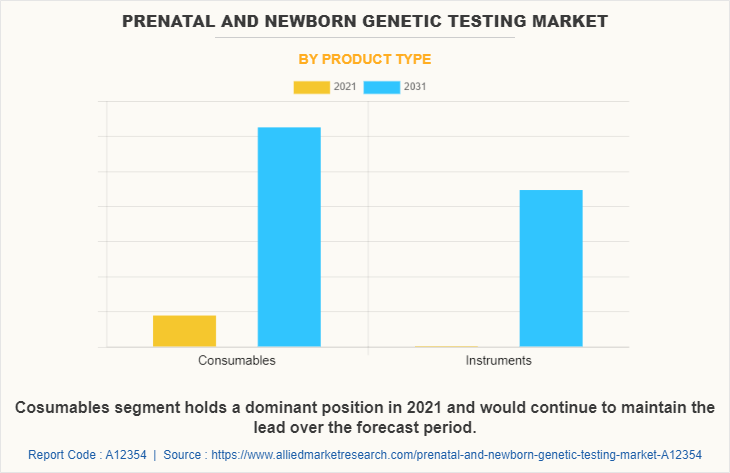
On the basis of screening the market is segmented into non-invasive prenatal testing (NIPT), chronic villus sampling (CVS), amniocentesis, maternal serum screening (MSS), and others. non-invasive prenatal testing (NIPT) is the largest and fastest-growing segment during the forecast period owing to, rise in awareness about prenatal testing and an increase in the number of pregnant women undergoing non-invasive prenatal testing (NIPT).
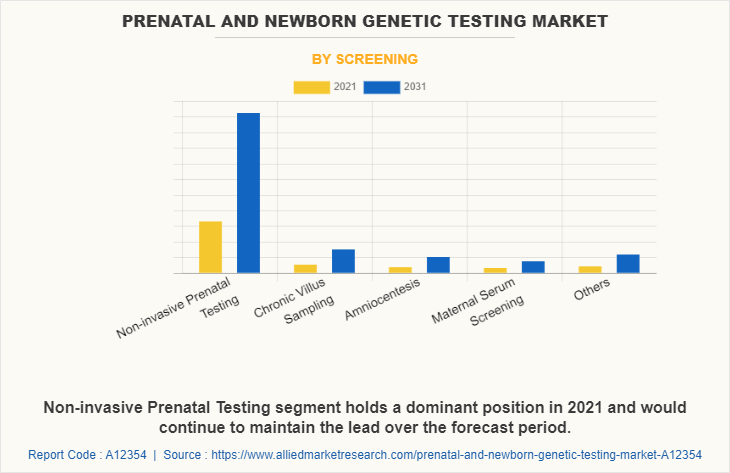
By disease: Prenatal and the newborn genetic testing market is segregated into Down’s syndrome, phenylketonuria, cystic fibrosis, sickle cell anemia, and others. The Down syndrome segment dominated the global market in 2021. This is attributed to the fact that Down syndrome is one of the most prevalent chromosomal anomalies, thus a growing number of newborn babies suffering from Down syndrome increases the use of newborn genetic testing and augments the market growth.
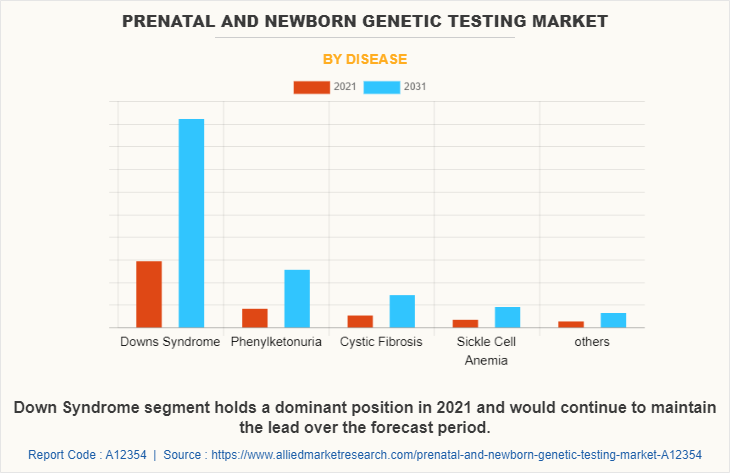
By end user: the market is classified into hospitals, maternity and specialty clinics, and diagnostic centers. The hospital's segment held the largest market share in 2021, owing to the availability of trained medical staff in hospitals that helps to provide better services to patients and it provides additional benefits of diagnosis and treatment of neuromuscular disorders including genetic conditions. On the other hand, maternity and specialty clinics is the fastest growing segment during the forecast period, as it offers complete pre-pregnancy and prenatal care which further reduces the risk of pregnancy complications.
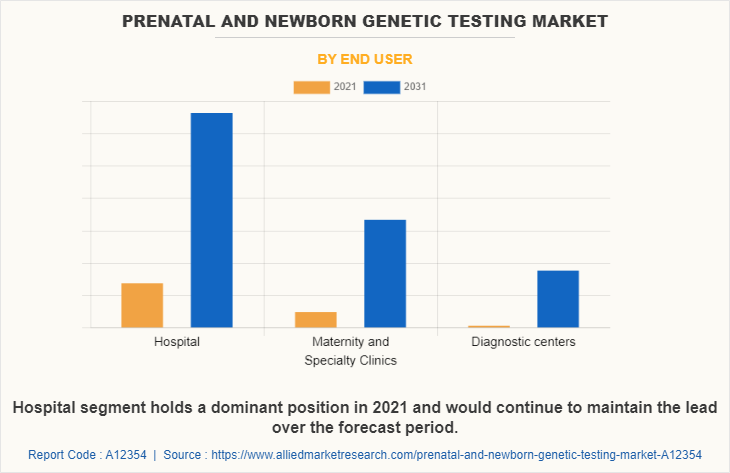
By region: The Prenatal and Newborn Genetic Testing Industry is analyzed across North America, Europe, Asia-Pacific, and LAMEA. North America accounted for a major share of the prenatal and newborn genetic testing market in 2021 and is expected to maintain its dominance during the forecast period, owing to the strong presence of several major players, such as, Abbott Laboratories, PerkinElmer Inc., and Mettler Toledo, and technological advancement in PCR diagnostic methods. In addition, the rise in the number of pregnant women undergoing genetic screening in this region also contributes to the growth of the market. Moreover, high purchasing power and a rise in awareness about various inborn genetic diseases are expected to drive market growth. For instance, World Down Syndrome Day is marked each year on the 21st of March to spread awareness about diagnosis and treatment for people suffering from Down syndrome.
Asia-Pacific is expected to grow at the fastest rate during the forecast period. This is attributed to the presence of several medical device companies in the region as well as growth in the purchasing power of populated countries, such as Japan and India. Moreover, the rise in healthcare expenditure and growing adoption of novel screening methods, and an increase in the pregnancy rate drive the growth of the market. Furthermore, the Asia-Pacific is the larger medical devices industry with the availability of raw materials in abundance, which can be easily accessed by manufacturers, this, in turn, drives the growth of the market. Asia-Pacific offers profitable opportunities for key players operating in the prenatal and newborn genetic testing market, thereby registering the fastest growth rate during the forecast period, owing to, an increase in disposable incomes, as well as the well-established presence of domestic companies in the region. In addition, rise in genetic abnormalities in newborn babies further boosts the growth of the market.
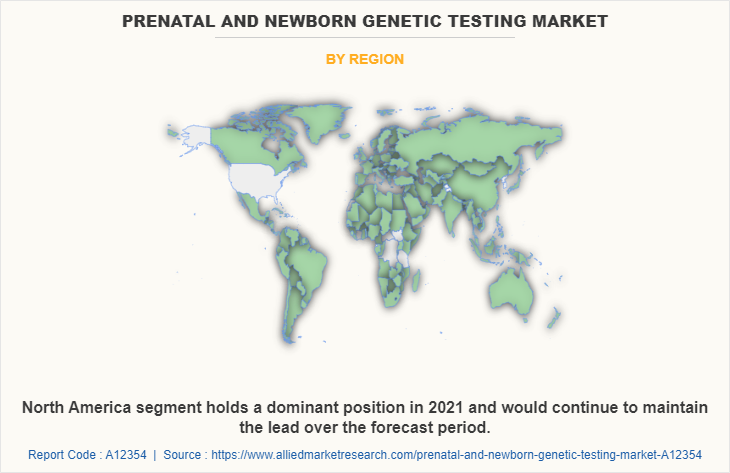
COMPETITION ANALYSIS
Competitive analysis and profiles of the major players in the prenatal and newborn genetic testing market, such as Bio-Rad Laboratories, Inc., PerkinElmer Inc., Natera, Inc., Quest Diagnostics Incorporated, F. Hoffmann-La Roche AG, Mettler Toledo, Laboratory Corporation of America Holdings, Thermo Fisher Scientific Inc., Abbott Laboratories, and BGI Group are provided in this report. There are some important players in the market such as Illumina Inc., Trivitron Healthcare, and Berry Genomics. Major players have adopted product launch, product approval, and agreement as key developmental strategies to improve the product portfolio of the prenatal and newborn genetic testing market.
Some examples of product launches in the market
F. Hoffman-La Roche AG has launched the Digital LightCycler System a next-generation digital PCR system that helps physicians to better understand the nature of genetic diseases.
Product approval in the market
PerkinElmer Inc. announced the Food and Drug Administration (FDA) approval for the EONIS SCID-SMA assay kit for in vitro diagnostic to detect spinal muscular atrophy and severe combined immunodeficiency in newborns. Such product approval will help the company to further gain a strong foothold in the prenatal and newborn genetic testing market.
Key Benefits For Stakeholders
- This report provides a quantitative analysis of the market segments, current trends, estimations, and dynamics of the prenatal and newborn genetic testing market analysis from 2021 to 2031 to identify the prevailing prenatal and newborn genetic testing market opportunities.
- The market research is offered along with information related to key drivers, restraints, and opportunities.
- Porter's five forces analysis highlights the potency of buyers and suppliers to enable stakeholders make profit-oriented business decisions and strengthen their supplier-buyer network.
- In-depth analysis of the prenatal and newborn genetic testing market segmentation assists to determine the prevailing market opportunities.
- Major countries in each region are mapped according to their revenue contribution to the global market.
- Market player positioning facilitates benchmarking and provides a clear understanding of the present position of the market players.
- The report includes the analysis of the regional as well as global prenatal and newborn genetic testing market trends, key players, market segments, application areas, and market growth strategies.
Prenatal and Newborn Genetic Testing Market Report Highlights
| Aspects | Details |
| Market Size By 2031 | USD 14.7 billion |
| Growth Rate | CAGR of 11.5% |
| Forecast period | 2021 - 2031 |
| Report Pages | 256 |
| By Product Type |
|
| By Screening |
|
| By Disease |
|
| By End User |
|
| By Region |
|
| Key Market Players | BGI Group, Bio-Rad Laboratories, Inc., Quest Diagnostics Incorporated, Laboratory Corporation of America Holdings, Mettler Toledo, Abbott Laboratories, PerkinElmer Inc., F. Hoffmann-La Roche AG, Natera, Inc., Thermo Fisher Scientific Inc. |
Analyst Review
This section provides various opinions of the top-level CXOs in the global prenatal and newborn genetic testing industry. In accordance with several interviews conducted, the prenatal and newborn genetic testing market is expected to witness healthy growth with the rise in the demand for non-invasive prenatal testing. In addition, an increased number of pregnancies leads to high adoption of prenatal genetic testing which are expected to significantly boost the growth of the prenatal and newborn genetic testing market. However, the high cost of screening tests restricts the growth of the market.?
According to the perspective of CXOs of leading companies in the market, the global prenatal and newborn genetic testing market is expected to exhibit high growth potential attributable to factor such as an increase in awareness regarding the advantages of early-stage prenatal and newborn genetic testing.??
The CXOs further added that North America is expected to witness the highest growth, in terms of revenue, owing to an increase in the knowledge about novel devices is expected to boost the demand for prenatal and newborn genetic testing in this region. However, Asia-Pacific is expected to register the fastest CAGR during the forecast period due to a rise in awareness regarding the benefits of prenatal and newborn genetic testing in the diagnosis of genetic diseases, unmet medical demands, and an increase in public–private investments in the healthcare sector.
The prenatal and newborn genetic testing market growth is driven by the rise in the incidence and prevalence of genetic diseases such as cystic fibrosis, Down’s syndrome, phenylketonuria, and others and rise in technological advancement in methods of prenatal and newborn genetic testing. The rise in prevalence of genetic diseases, propel high adoption of prenatal and newborn genetic testing for diagnosis of diseases.
The total market value of the Prenatal and Newborn Genetic Testing market is $ 4,891.51 million in 2021
North America the largest regional market for Prenatal and Newborn Genetic Testing
$14,727.30 million is the estimated industry size of Prenatal and Newborn Genetic Testing in 2031
The top companies to hold the market share in Prenatal and Newborn Genetic Testingare Bio-Rad Laboratories, Inc., PerkinElmer Inc., Natera, Inc., Quest Diagnostics Incorporated,
The base year for the report is 2021
Yes, Prenatal and Newborn Genetic Testing market companies are profiled in the report
No, there is value chain analysis provided in the Prenatal and Newborn Genetic Testing market report
Loading Table Of Content...



